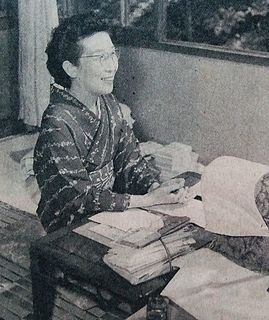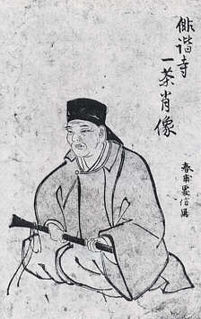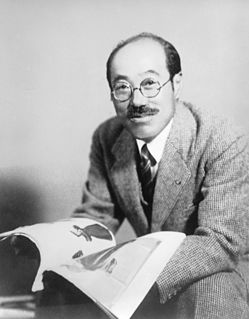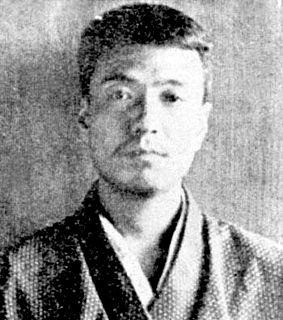 W
WRyūnosuke Akutagawa , art name Chōkōdō Shujin (澄江堂主人), was a Japanese writer active in the Taishō period in Japan. He is regarded as the "father of the Japanese short story", and Japan's premier literary award, the Akutagawa Prize, is named after him. He committed suicide at the age of 35 through an overdose of barbital.
 W
WArakida Moritake was a Japanese poet who excelled in the fields of waka, renga, and in particular haikai. He studied renga with Sōgi. He was the son of Negi Morihide, and a Shintoist. At the age of 69, he became head priest of the Inner Ise Shrine.
 W
WHanabusa Itchō was a Japanese painter, calligrapher, and haiku poet. He originally trained in the Kanō style, under Kanō Yasunobu, but ultimately rejected that style and became a literati (bunjin). He was also known as Hishikawa Waō and by a number of other art-names.
 W
WKawahigashi Hekigotō, birth name Kawahigashi Heigorō, was a Japanese poet and modern pioneer of the haiku form.
 W
WTatsuko Hoshino was a Japanese haiku poet active in Shōwa period Japan.
 W
WDakotsu Iida was a Japanese haiku poet from what is now part of the city of Fuefuki, Yamanashi, Japan. Commonly referred to as Dakotsu, his real name was Takeji Iida . He trained under Kyoshi Takahama, and was a frequent contributor to such haiku journals as Hototogisu (magazine) and Unmo. He was chief editor of Unmo until his death, upon which his son, the prominent haiku poet Ryuta Iida, took over as the editor of Unmo.
 W
WIshida Hakyō was a Japanese haiku poet.
 W
WTomoji Ishizuka was the pen-name of Ishizuka Tomoji, a Japanese haiku poet and novelist active during the Shōwa period of Japan.
 W
WTōta Kaneko , was a Japanese writer.
 W
WKarai Senryū , whose real name is Karai Hachiemon was a Japanese poet and poetry judge (tenja). He popularized a form of haiku called senryū, which is named after him. "Senryū" was the nickname that he adopted when he started judging poetry, and other poetry judges after him also adopted this name. The word senryū means "river willow" in Japanese.
 W
WMurakami Kijo was a Japanese poet who wrote haiku.
 W
WKobayashi Issa was a Japanese poet and lay Buddhist priest of the Jōdo Shinshū. He is known for his haiku poems and journals. He is better known as simply Issa (一茶), a pen name meaning Cup-of-tea. He is regarded as one of the four haiku masters in Japan, along with Bashō, Buson and Shiki — "the Great Four."
 W
WMasao Kume was a Japanese popular playwright, novelist and haiku poet active during the late Taishō and early Shōwa periods of Japan. His wife and the wife of Nagai Tatsuo were sisters, making them brothers-in-law.
 W
WMasaoka Shiki , pen-name of Masaoka Noboru, was a Japanese poet, author, and literary critic in Meiji period Japan. Shiki is regarded as a major figure in the development of modern haiku poetry, credited with writing nearly 20,000 stanzas during his short life. He also wrote on reform of tanka poetry.
 W
WTakashi Matsumoto was a Japanese haiku poet active in Shōwa period Japan.
 W
WMatsuo Bashō, born Matsuo Kinsaku, then Matsuo Chūemon Munefusa, was the most famous poet of the Edo period in Japan. During his lifetime, Bashō was recognized for his works in the collaborative haikai no renga form; today, after centuries of commentary, he is recognized as the greatest master of haiku. He is also well known for his travel essays beginning with “Records of a Weather-Exposed Skeleton” (1684), written after his journey west to Kyoto and Nara. Matsuo Bashō's poetry is internationally renowned, and, in Japan, many of his poems are reproduced on monuments and traditional sites. Although Bashō is famous in the West for his hokku, he himself believed his best work lay in leading and participating in renku. He is quoted as saying, "Many of my followers can write hokku as well as I can. Where I show who I really am is in linking haikai verses."
 W
WShūōshi Mizuhara was a Japanese haiku poet and physician.
 W
WMukai Kyorai was a Japanese haikai poet, and a close disciple of Matsuo Bashō.
 W
WTatsuo Nagai was a writer of short stories, novels, and essays, active in the Shōwa period Japan, known for his portrayals of city life. Nagai was also known as a haiku poet under the pen-name of "Tomonkyo".
 W
WNatsume Sōseki , born Natsume Kin'nosuke , was a Japanese novelist. He is best known around the world for his novels Kokoro, Botchan, I Am a Cat, Kusamakura and his unfinished work Light and Darkness. He was also a scholar of British literature and writer of haiku, kanshi, and fairy tales. From 1984 until 2004, his portrait appeared on the front of the Japanese 1,000 yen note.
 W
WNozawa Bonchō was a Japanese haikai poet. He was born in Kanazawa, and spent most of his life in Kyoto working as a doctor. Bonchō was one of Matsuo Bashō's leading disciples and, together with Kyorai, he edited the Bashō school's Monkey's Raincoat (Sarumino) anthology of 1689. He participated in numerous renku with Bashō and other members of his Shōmon school.
 W
WOgiwara Seisensui was the pen-name of Ogiwara Tōkichi, a Japanese haiku poet active during the Taishō and Shōwa periods of Japan.
 W
WOzaki Kōyō was a Japanese author and poet. His real name was Ozaki Tokutarō , and he was also known by various noms de plume including Enzan (縁山) and Tochimandō (十千万堂).
 W
WSokotsu Samukawa was a Haiku poet in Japan during the Meiji period. Sokotsu was a pen name and his real name was Akimitsu (陽光).
 W
WShiba Sonome was a Japanese zen poet. She was an acquaintance and friend of Matsuo Bashō, and their correspondence is a treasure of zen and haiku history. On a final visit in 1694, Bashō paid homage to her in a haiku, hiragiku no me ni tatete miru chiri mo nashi, 白菊の目に立てゝ見る塵もなし, in the eye of a white chrysanthemum, there is not a speck of dust.
 W
WKyoshi Takahama was a Japanese poet active during the Shōwa period of Japan. His real name was Takahama Kiyoshi (高浜清); Kyoshi was a pen name given to him by his mentor, Masaoka Shiki.
 W
WTakarai Kikaku also known as Enomoto Kikaku, was a Japanese haikai poet and among the most accomplished disciples of Matsuo Bashō. His father was an Edo doctor, but Kikaku chose to become a professional haikai poet rather than follow in his footsteps.
 W
WTaneda Santōka was the pen-name of a Japanese author and haiku poet. He is known for his free verse haiku — a style which does not conform to the formal rules of traditional haiku.
 W
WHyakken Uchida was a Japanese author and academic.
 W
WUejima Onitsura was a Japanese haiku poet of the Edo period, famous in the Osaka region for his haiku poetry. Belonging to the Danrin school of Japanese poetry, Uejima is credited of helping to define and exemplify Bashō's style of poetry.
 W
WYamaguchi Seishi was a Japanese haiku poet.
 W
WYokoi Yayū was a Japanese samurai best known for his haibun, a scholar of Kokugaku, and haikai poet. He was born Yokoi Tokitsura , and took the pseudonym Tatsunojō. His family are believed to be descendants of Hōjō Tokiyuki.
 W
WYosa Buson or Yosa no Buson was a Japanese poet and painter of the Edo period. Along with Matsuo Bashō and Kobayashi Issa, Buson is considered among the greatest poets of the Edo Period. And, he is known for completing haiga as a style of art.